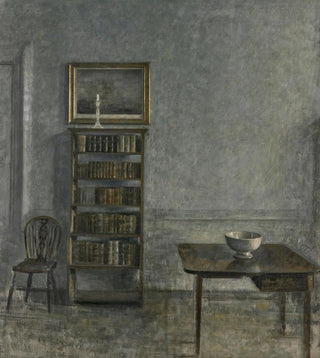Art print | Interior with a table, bookshelf, and Windsor chair: 25 Strandgade - Vilhelm Hammershøi


View from behind

Frame (optional)
Interior Art print with a table, bookshelf, and Windsor chair: 25 Strandgade - Vilhelm Hammershøi – Captivating introduction
In the fascinating world of Danish painting, Vilhelm Hammershøi's work "Interior with a table, bookshelf, and Windsor chair: 25 Strandgade" stands out for its ability to capture the essence of domestic intimacy. This painting, imbued with melancholy and serenity, transports the viewer to a space where time seems to stand still. The delicate nuances and play of light create a soothing atmosphere, inviting contemplation. The artist, through this masterpiece, offers us a glimpse of his unique vision of the world, where each element of the composition plays a vital role in visual storytelling.
Style and uniqueness of the work
Hammershøi's style is characterized by an intimate approach and a palette of subtle colors. In this piece, natural light filters through the windows, gently illuminating the surfaces and creating soft shadows that add an almost tactile dimension to the scene. The table, bookshelf, and Windsor chair are not mere objects; they become actors within the space, silent witnesses to a poetic daily life. The clean lines and geometric shapes are typical of his style, while the use of empty space enhances the feeling of solitude and reflection. Hammershøi manages to transform an ordinary interior into a place of emotion, where every detail, from the grain of the wood to the texture of the walls, contributes to an atmosphere of calm and contemplation.
The artist and his influence
Vilhelm Hammershøi, an emblematic figure of the Danish artistic movement at the end of the 19th century and the beginning of the 20th, developed a visual language unique to him. Influenced by symbolism and realism, he focused on themes of everyday life, exploring solitude and introspection. Hammershøi often painted interiors of houses, highlighting the relationship between space and the individual. His work was rediscovered in the 20th century, and today he is recognized not only for his technique but also for his ability to evoke deep emotions through

Matte finish

View from behind

Frame (optional)
Interior Art print with a table, bookshelf, and Windsor chair: 25 Strandgade - Vilhelm Hammershøi – Captivating introduction
In the fascinating world of Danish painting, Vilhelm Hammershøi's work "Interior with a table, bookshelf, and Windsor chair: 25 Strandgade" stands out for its ability to capture the essence of domestic intimacy. This painting, imbued with melancholy and serenity, transports the viewer to a space where time seems to stand still. The delicate nuances and play of light create a soothing atmosphere, inviting contemplation. The artist, through this masterpiece, offers us a glimpse of his unique vision of the world, where each element of the composition plays a vital role in visual storytelling.
Style and uniqueness of the work
Hammershøi's style is characterized by an intimate approach and a palette of subtle colors. In this piece, natural light filters through the windows, gently illuminating the surfaces and creating soft shadows that add an almost tactile dimension to the scene. The table, bookshelf, and Windsor chair are not mere objects; they become actors within the space, silent witnesses to a poetic daily life. The clean lines and geometric shapes are typical of his style, while the use of empty space enhances the feeling of solitude and reflection. Hammershøi manages to transform an ordinary interior into a place of emotion, where every detail, from the grain of the wood to the texture of the walls, contributes to an atmosphere of calm and contemplation.
The artist and his influence
Vilhelm Hammershøi, an emblematic figure of the Danish artistic movement at the end of the 19th century and the beginning of the 20th, developed a visual language unique to him. Influenced by symbolism and realism, he focused on themes of everyday life, exploring solitude and introspection. Hammershøi often painted interiors of houses, highlighting the relationship between space and the individual. His work was rediscovered in the 20th century, and today he is recognized not only for his technique but also for his ability to evoke deep emotions through






